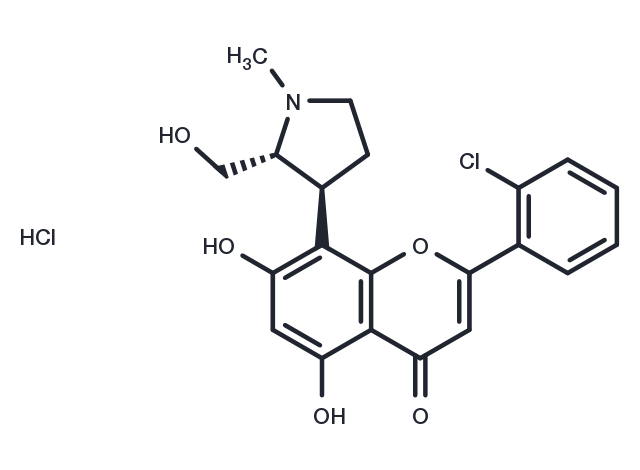Powder: -20°C for 3 years | In solvent: -80°C for 1 year


Riviciclib hydrochloride (P276-00) is a novel CDK1, CDK4 and CDK9 inhibitor with IC50 of 79 nM, 63 nM and 20 nM, respectively. Phase 2/3.

| Pack Size | Availability | Price/USD | Quantity |
|---|---|---|---|
| 1 mg | In stock | $ 66.00 | |
| 2 mg | In stock | $ 97.00 | |
| 5 mg | In stock | $ 150.00 | |
| 10 mg | In stock | $ 247.00 | |
| 25 mg | In stock | $ 450.00 | |
| 50 mg | In stock | $ 663.00 | |
| 1 mL * 10 mM (in DMSO) | In stock | $ 156.00 |

| Description | Riviciclib hydrochloride (P276-00) is a novel CDK1, CDK4 and CDK9 inhibitor with IC50 of 79 nM, 63 nM and 20 nM, respectively. Phase 2/3. |
| Targets&IC50 | CDK4-CyclinD1:63 nM, CDK9-CyclinT1:20 nM, CDK1-CyclinB:79 nM |
| In vitro | P276-00 shows 40-fold selectivity toward Cdk4-D1, compared with Cdk2-E[1]. It shows potent antiproliferative effects against various human cancer cell lines, including HCT-116, U2OS, H-460, HL-60, HT-29, SiHa, MCF-7, Colo-205, SW-480, PC-3, Caco2, T-24 with an IC50 ranging from 300 to 800 nmol/L, and is found to be highly selective for cancer cells as compared with normal fibroblast cells[1]. P276-00 can down-regulate cyclin D1 and Cdk4 in an ATP- competitive manner and decrease Cdk4-specific pRb Ser780 phosphorylation. P276-00 also induces apoptosis by actving cellular caspase-3 activity and DNA ladder formation[1]. |
| In vivo | P276-00, administered i.p. at 50 mg/kg daily for 20 treatments can significantly induce growth inhibition of murine colon cancer (CA-51). However, in murine lung carcinoma model (Lewis lung), an increased dose of 60 mg/kg (30 mg/kg twice daily) administered every alternate day i.p. for 7 treatments shows significant inhibition in the growth[2]. And it also inhibit the growth of human colon carcinoma HCT-116 xenograft and human non-small cell lung carcinoma H-460 xenograft[2]. Efficacy Studies show its maximum tolerated dose is 78 mg/kg/d[2]. |
| Kinase Assay | Cdk4-D1/Cdk2-E enzyme assay: The Cdk4-D1/Cdk2-E enzyme assay is run in 96-well format using Millipore Multiscreen filtration plates. All assay steps are done in a single filter plate. The filtration wells are prewetted with 100 μL of kinase buffer [50 mmol/L HEPES (pH, 7.5), 10 mmol/L MgCl2, 1 mmol/L EGTA], and then the solution is removed by vacuum. With filter plate on vacuum manifold, 50 μL GST-Rb bound to GSH-Sepharose beads in kinase buffer (0.5 μg GST-Rb/50 μL) is added to each well, and vacuum is applied to the filter plate. About 25 μL of a reaction mix containing ATP (cold + hot) and 4× phosphatase inhibitor mix (40 μMol/L unlabeled ATP, 10 μCi/mL γ32P-ATP, 40 mmol/L h-glycerophosphate, 4 mmol/L DTT, 0.4 mmol/L NaF, 0.4 mmol/L sodium orthovanadate) diluted in kinase buffer is added to each well. The test compound (4×final concentration in kinase buffer) or kinase buffer alone (control) is then added in an additional 25 μL volume. To each well, 50 μL (100 ng) of human Cdk4-D1/Cdk2-E enzyme in kinase buffer is added to initiate the reaction, which is allowed to continue for 30 min at 30°C. When the reaction is completed, vacuum is applied again, and the plate is washed with the TNEN buffer [20 mmol/L Tris (pH, 8.0), 100 mmol/L NaCl, 1 mmol/L EDTA, 0.5% nonidet-P40] thrice; the filter plate is air-dried and is placed in a Multiscreen adapter plate. Packard Microscint-O cocktail (30 μL) is added, and the plate is covered with a Top-Seal A film. Quantitation of 32P-GST-Rb in 96-well filter plates is carried out by Top Count scintillation counter. All compounds are tested initially at 1 μMol/L concentration. Compounds showing more than or equal to 50% inhibition are further profiled for IC50 determination. |
| Cell Research | The cells are seeded at a density of 3,000-5,000 cells per well, depending on cell type in 180 μL of culture medium in 96-well plate and incubated overnight to allow the cells to adhere. Varying concentrations of compounds are added to the wells and incubated for 48 h at 37°C. 3H-thymidine (0.25 μCi) is added to each well, and incorporation of the radiolabel is allowed to proceed for 5 to 7 h. Following this incubation, cells are harvested onto GF/B unifilter plates using a Packard Filtermate Universal harvester, and the plates are counted in a Packard Top Count 96-well liquid scintillation counter. (Only for Reference) |
| Synonyms | P276-00 |
| Molecular Weight | 438.3 |
| Formula | C21H20ClNO5·HCl |
| CAS No. | 920113-03-7 |
Powder: -20°C for 3 years | In solvent: -80°C for 1 year
Ethanol: 7 mg/mL (15.97 mM)
DMSO: 82 mg/mL (187.1 mM)
H2O: 81 mg/mL (184.8 mM)
You can also refer to dose conversion for different animals. More
bottom
Please see Inhibitor Handling Instructions for more frequently ask questions. Topics include: how to prepare stock solutions, how to store products, and cautions on cell-based assays & animal experiments, etc.
Riviciclib hydrochloride 920113-03-7 Apoptosis Cell Cycle/Checkpoint CDK inhibit P276-00 Inhibitor Riviciclib Riviciclib Hydrochloride Cyclin dependent kinase inhibitor
